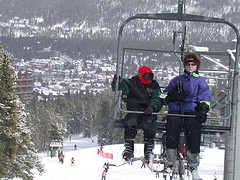5 Insurance Tips for Safer Ski and Snowboard Trips
6 December 2013
It’s ski and snowboard season across the U.S. and as travelers make their holiday and ski trip plans, we wanted to give you some insurance tips to help you protect yourself.
Start with a quick reminder of the Heads Up Responsibility Code, which is the responsibility of everyone who skis or snowboards.
To get started, let’s take a look at some sobering facts from the National Ski Areas Association (NSAA) from October 1, 2012:
- During the past 10 years 41.5 people have died PER YEAR while skiing or snowboarding
- During the 2011/2012 season, there were 54 fatalities – 33 male and 6 female
- Serious injuries (paralysis, serious head injuries, and others) occur at a rate of about 44.7 PER YEAR
- During the 2011/2012 season, there were 510 serious injuries.
Regarding the use of helmets? The jury is out according to the NSAA: 36 of last season’s 54 deaths and 30 of the serious injuries were reported as wearing a helmet at the time of the incident.
To put these facts into perspective, it’s important to compare the numbers against the number of participants:
- Number of ski/snowboard participants in 2011 was 9.8 million
And for a little more perspective, the report goes on to indicate that according to Dr. Jasper Shealy, professor emeritus at the Rochester Institute of Technology in Rochester, N.Y., who has studied ski related injuries for more than 30 years, the overall rate of injuries has declined by almost half since the early 1970s when the once-feared broken lower leg topped the injury list.
The victims of fatalities and fatal injuries are predominantly above-average skiers and snowboards who are going at high rates of speed on the margins of intermediate trails.
To ensure that your ski/snowboard trip is safe, we put together these travel insurance tips to help you protect yourself and your family.
1. Check the Range of your Health Insurance
It’s important to check the range of your health insurance prior to a ski/snowboard trip and here’s why: if your network extends only within the range of your state of residence and you’re traveling to another state, you will be paying out-of-network costs for any medical care you receive on your trip.
If your dare-devil daughter misses a turn and tumbles into a tree and needs surgery, your medical bills could leave you bankrupt.
Know whether your health insurance will cover emergency medical care and transportation where you are traveling before you leave and consider travel insurance for the rest.
If you will be out of your health insurance network, this one step could save you from financial ruin and travel medical insurance is extremely cheap.
2. Cover the Hazardous Sport and Know the Limits
While many travel insurance plans include coverage for medical accidents due to skiing and snowboarding, many do not. It’s important to read the fine print and understand what your plan will cover in case of an accident.
It’s also important to understand the limits of your plan. For example, many plans limit skiers from coverage if they are skiing outside the marked trails. Plans will always deny coverage if the skier was under the influence when the accident occurred too, so watch your intake.
3. Ski Season Road Closures Can Wreak Havoc
Travel delays don’t just occur at the airport. As just one example, from Denver International Airport west to the most popular ski resorts in Colorado skiers and snowboards essentially travel one highway (I-70). The Colorado Department of Transportation (CDOT) will close the road when snow conditions are heavy.
Of course, those same conditions make for really fun skiing, but if you’re still trying to arrive, you could be facing unexpected hotel costs while you wait out the road closure.
A travel insurance plan with adequate travel delay protection can cover those costs (up to the plan limits) and ease the pain.
4. Get Smart about your Pre-Paid Trip Costs
If you want to have protection against unexpected trip cancellations and interruption, it’s necessary to cover all your pre-paid trip costs – that means:
- Airline tickets
- Hotel/condominium reservations
- Car rentals
- Lift Tickets
- Ground transportation tickets
Any non-refundable expense you pay for before you leave needs to be included in the total insured amount. The hotels and ski resorts have long since followed the airlines in making most pre-paid reservations completely non-refundable, so it’s important to note that fact and insure them.
5. Lost or Stolen Equipment is Expensive to Replace
If the equipment you take along on your trip is lost or stolen, you’ll have to rent or buy new equipment and that can be a pricey deal. Sporting equipment nearly always has to be checked in simply because it’s too big to fit in the overhead bins, and the airlines only provide limited coverage for the items they lose or destroy, even if the gear is valuable.
Travel insurance also has per-item maximums for sporting equipment but you can buy plans with extra protection that will cover your rental fees.
Nearly always, we recommend that travelers look into scheduling their sporting equipment on their homeowners policy because the coverage is better.
Damian Tysdal is the founder of CoverTrip, and is a licensed agent for travel insurance (MA 1883287). He believes travel insurance should be easier to understand, and started the first travel insurance blog in 2006.

